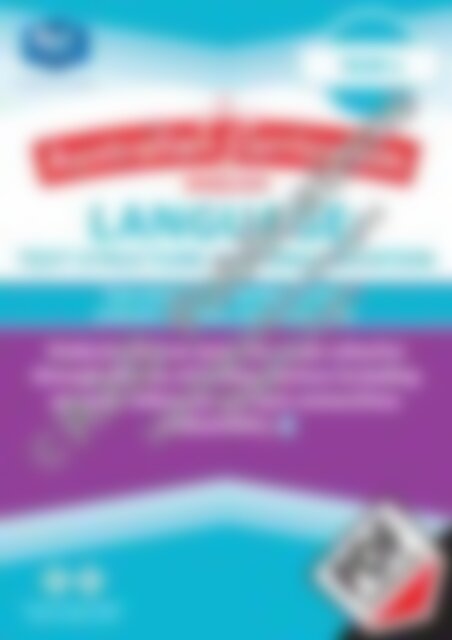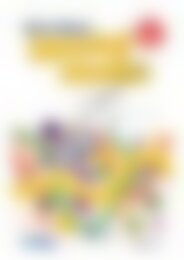20888 ACE Language (Yr 4) Pronoun Reference and Text Connectives
Create successful ePaper yourself
Turn your PDF publications into a flip-book with our unique Google optimized e-Paper software.
Your partner in education<br />
YEAR 4<br />
ENGLISH<br />
LANGUAGE:<br />
TEXT STRUCTURE AND ORGANISATION<br />
<strong>Text</strong> cohesion <strong>and</strong> linking devices:<br />
pronoun reference, text connectives<br />
Underst<strong>and</strong> how texts are made cohesive<br />
through the use of linking devices including<br />
pronoun reference <strong>and</strong> text connectives<br />
(<strong>ACE</strong>LA1491)<br />
Australian Primary Publisher<br />
of the Year 2015 <strong>and</strong> 2016
Australian Curriculum English – <strong>Language</strong>: <strong>Text</strong> structure <strong>and</strong> organisation (Year 4)<br />
Foreword<br />
Australian Curriculum English – <strong>Language</strong>: <strong>Text</strong> structure <strong>and</strong> organisation (Year 4) is one in a series of seven teacher<br />
resource books that support teaching <strong>and</strong> learning activities in Australian Curriculum English. The books focus on<br />
the sub-str<strong>and</strong> of <strong>Text</strong> structure <strong>and</strong> organisation within the <strong>Language</strong> str<strong>and</strong> of the national English curriculum.<br />
The resource books include theoretical background information, activities to develop the content descriptions, blackline<br />
masters, resource sheets <strong>and</strong> assessment checklists, along with interrelated links to other English str<strong>and</strong>s <strong>and</strong> sub-str<strong>and</strong>s.<br />
Titles in this series are:<br />
• Australian Curriculum English – <strong>Language</strong>: <strong>Text</strong> structure <strong>and</strong> organisation (Foundation)<br />
• Australian Curriculum English – <strong>Language</strong>: <strong>Text</strong> structure <strong>and</strong> organisation (Year 1)<br />
• Australian Curriculum English – <strong>Language</strong>: <strong>Text</strong> structure <strong>and</strong> organisation (Year 2)<br />
• Australian Curriculum English – <strong>Language</strong>: <strong>Text</strong> structure <strong>and</strong> organisation (Year 3)<br />
• Australian Curriculum English – <strong>Language</strong>: <strong>Text</strong> structure <strong>and</strong> organisation (Year 4)<br />
• Australian Curriculum English – <strong>Language</strong>: <strong>Text</strong> structure <strong>and</strong> organisation (Year 5)<br />
• Australian Curriculum English – <strong>Language</strong>: <strong>Text</strong> structure <strong>and</strong> organisation (Year 6)<br />
Contents<br />
Format of this book .................................. iv – v<br />
<strong>Language</strong>: <strong>Text</strong> structure <strong>and</strong><br />
organisation .............................................. 2–77<br />
Underst<strong>and</strong> how texts vary in complexity <strong>and</strong><br />
technicality depending on the approach to the topic,<br />
the purpose <strong>and</strong> intended audience (<strong>ACE</strong>LA1490)<br />
© Australian Curriculum: Assessment <strong>and</strong> Reporting Authority 2012<br />
–Teacher information ................................................. 2<br />
–Activities to develop the content description ....... 3–9<br />
–Blackline masters ............................................. 10–27<br />
–Assessment checklist ............................................. 28<br />
–Interrelated English links ........................................ 29<br />
– Modes, capabilities <strong>and</strong> priorities covered by the<br />
activities in this content description ....................... 29<br />
Underst<strong>and</strong> how texts are made cohesive through the<br />
use of linking devices including pronoun reference <strong>and</strong><br />
text connectives (<strong>ACE</strong>LA1491)<br />
© Australian Curriculum: Assessment <strong>and</strong> Reporting Authority 2012<br />
–Teacher information ............................................... 30<br />
–Activities to develop the content description ......... 31<br />
–Blackline masters <strong>and</strong> resource sheets .............. 32–41<br />
–Assessment checklist ............................................. 42<br />
–Interrelated English links ........................................ 43<br />
– Modes, capabilities <strong>and</strong> priorities covered by the<br />
activities in this content description ....................... 43<br />
Recognise how quotation marks are used in texts<br />
to signal dialogue, titles <strong>and</strong> quoted (direct)<br />
speech (<strong>ACE</strong>LA1492)<br />
© Australian Curriculum: Assessment <strong>and</strong> Reporting Authority 2012<br />
–Teacher information ............................................... 44<br />
–Activities to develop the content description ......... 45<br />
–Blackline masters <strong>and</strong> resource sheets ............. 46–53<br />
–Assessment checklist ............................................. 54<br />
–Interrelated English links ........................................ 55<br />
– Modes, capabilities <strong>and</strong> priorities covered by the<br />
activities in this content description ....................... 55<br />
Identify features of online texts that enhance readability<br />
including text, navigation, links, graphics <strong>and</strong><br />
layout (<strong>ACE</strong>LA1793)<br />
© Australian Curriculum: Assessment <strong>and</strong> Reporting Authority 2012<br />
–Teacher information ............................................... 56<br />
–Activities to develop the content description ......... 57<br />
–Blackline masters <strong>and</strong> resource sheets ............. 58–75<br />
–Assessment checklist ............................................. 76<br />
–Interrelated English links ........................................ 77<br />
– Modes, capabilities <strong>and</strong> priorities covered by the<br />
activities in this content description ....................... 77<br />
Answers .................................................... 78–83<br />
R.I.C. Publications ® www.ricpublications.com.au Australian Curriculum English – <strong>Language</strong>: <strong>Text</strong> structure <strong>and</strong> organisation (Year 4)<br />
iii
Format of the book<br />
This teacher resource book includes supporting materials for teaching <strong>and</strong> learning in the sub-str<strong>and</strong> of <strong>Text</strong> structure<br />
<strong>and</strong> organisation within the str<strong>and</strong> of <strong>Language</strong> in Australian Curriculum English. All content descriptions in the substr<strong>and</strong><br />
have been included, as well as teaching points based on the Curriculum’s elaborations.<br />
While the book focuses on the sub-str<strong>and</strong> of <strong>Text</strong> structure <strong>and</strong> organisation, activities <strong>and</strong> interrelated links to other<br />
str<strong>and</strong>s <strong>and</strong> sub-str<strong>and</strong>s have been incorporated.<br />
Each section supports a specific content description <strong>and</strong> follows a consistent format, containing the following<br />
information over several pages:<br />
• activities to develop the content descriptions • student blackline masters • resource sheets<br />
• interrelated English links<br />
• assessment checklist<br />
Answers relating to student blackline masters have been included at the back of the book.<br />
The length of each content description section varies.<br />
Teacher information includes background information relating to the content description, as well as<br />
related terms <strong>and</strong> desirable student vocabulary <strong>and</strong> other useful details which may assist the teacher.<br />
Related terms includes vocabulary<br />
associated with the content description.<br />
Many of these relate to the glossary<br />
in the back of the official Australian<br />
Curriculum English document;<br />
additional related terms may also have<br />
been added.<br />
Student vocabulary includes words<br />
which the teacher would use—<br />
<strong>and</strong> expect the students to learn,<br />
underst<strong>and</strong> <strong>and</strong> use—during English<br />
lessons.<br />
Further resources by R.I.C.<br />
Publications or other publishers<br />
or authors are included where<br />
appropriate.<br />
? What this means<br />
provides a general<br />
explanation of the content<br />
description.<br />
T Teaching points<br />
provides a list of<br />
the main teaching points<br />
relating to the content<br />
description.<br />
E Elaborations are a<br />
list of elaborations<br />
based on those in the<br />
content description.<br />
Activities to develop the content<br />
description includes descriptions or<br />
instructions for activities or games<br />
relating to the content descriptions<br />
or elaborations. Some activities are<br />
supported by blackline masters or<br />
resource sheets. Where applicable,<br />
these will be stated for easy reference.<br />
Australian Curriculum English – <strong>Language</strong>: <strong>Text</strong> structure <strong>and</strong> organisation (Year 4) www.ricpublications.com.au R.I.C. Publications ®<br />
iv
Format of the book.<br />
Blackline masters <strong>and</strong><br />
resource sheets are provided<br />
to support teaching <strong>and</strong><br />
learning activities for each<br />
content description. These<br />
include worksheets for class<br />
use, games, charts or other<br />
materials which the teacher<br />
might find useful to use or<br />
display in the classroom. For<br />
each blackline master the<br />
content description to which it<br />
relates is given.<br />
Interrelated English links<br />
lists other links covered within<br />
the <strong>Language</strong> str<strong>and</strong>, Literature<br />
str<strong>and</strong> <strong>and</strong> Literacy str<strong>and</strong> of<br />
English that are incorporated in<br />
the activities provided with the<br />
content description. While the<br />
book’s approach focuses on the<br />
<strong>Text</strong> structure <strong>and</strong> organisation<br />
sub-str<strong>and</strong>, the links show the<br />
integration across the three<br />
str<strong>and</strong>s.<br />
Each section has a checklist<br />
which teachers may find useful as<br />
a place to keep a record of their<br />
observations of the activities to<br />
develop the content descriptions.<br />
Answers for student worksheets<br />
are provided at the back of the<br />
book.<br />
A table showing the <strong>Language</strong><br />
modes, General capabilities<br />
<strong>and</strong> Cross-curriculum priorities<br />
covered by the activities in each<br />
content description is provided.<br />
R.I.C. Publications ® www.ricpublications.com.au Australian Curriculum English – <strong>Language</strong>: <strong>Text</strong> structure <strong>and</strong> organisation (Year 4)<br />
v
<strong>Text</strong> structure<br />
<strong>and</strong> organisation<br />
Underst<strong>and</strong> how texts are made cohesive through the use of linking devices including pronoun<br />
reference <strong>and</strong> text connectives (<strong>ACE</strong>LA1491)<br />
© Australian Curriculum: Assessment <strong>and</strong> Reporting Authority 2012<br />
Related terms<br />
<strong>Text</strong>s<br />
Written, spoken or multimodal forms of<br />
communication for a range of purposes. <strong>Text</strong><br />
forms, organisation <strong>and</strong> conventions have been<br />
developed to enhance effective communication.<br />
Cohesion<br />
Grammatical or lexical relationships that make<br />
links between different parts of a text <strong>and</strong> hold<br />
it together. Cohesion is achieved through devices<br />
such as paragraphs, connectives, ellipses <strong>and</strong><br />
word associations.<br />
Linking devices<br />
Devices used to connect different parts of a text,<br />
including paragraphs, connectives, ellipses <strong>and</strong><br />
word associations.<br />
<strong>Text</strong> connectives<br />
Words which link paragraphs <strong>and</strong> sentences in<br />
logical relationships of time, cause <strong>and</strong> effect,<br />
comparison or addition. <strong>Connectives</strong> relate ideas<br />
<strong>and</strong> help to show the logic of the information.<br />
Conjunctions<br />
Words that join other words, phrases <strong>and</strong> clauses<br />
in logical relationships such as time, cause <strong>and</strong><br />
comparison.<br />
Word associations<br />
The semantical relationships between words<br />
which form links within texts.<br />
Synonyms<br />
Words with the same or similar meaning.<br />
Antonyms<br />
Words with the opposite meaning.<br />
Noun phrase<br />
A noun with all its modifi ers <strong>and</strong> determiners.<br />
<strong>Pronoun</strong> reference<br />
The word a pronoun is replacing <strong>and</strong> referring to.<br />
Student vocabulary<br />
?<br />
T<br />
E<br />
What this means<br />
Teacher information<br />
• <strong>Text</strong>s only make sense because of the ways in which the separate parts are linked to<br />
form a cohesive whole.<br />
• Students need to recognise, underst<strong>and</strong> <strong>and</strong> use linking devices including pronoun<br />
reference <strong>and</strong> connectives in written texts.<br />
Teaching points<br />
• There can be many ideas in text, but they will only make sense to the reader if he/<br />
she can see how they are connected.<br />
• Writers show how things in a text are connected in many different ways.<br />
• <strong>Connectives</strong> are cohesive devices because they are used to link information, ideas,<br />
characters, events etc. in text <strong>and</strong> to show how they are connected.<br />
• Time connectives are used to link sections of text by sequencing events.<br />
• Word associations such as synonyms <strong>and</strong> antonyms make text more cohesive, add<br />
interest <strong>and</strong> can add meaning.<br />
• <strong>Pronoun</strong>s are used as synonyms to refer back to nouns <strong>and</strong> phrases in text, avoiding<br />
unnecessary repetition.<br />
Elaborations<br />
E1. Identifying <strong>and</strong> using different ways of naming the same thing, including word<br />
associations such as synonyms <strong>and</strong> antonyms, noun phrases <strong>and</strong> pronoun reference,<br />
<strong>and</strong> underst<strong>and</strong>ing that these devices provide cohesion, <strong>and</strong> add interest, variety <strong>and</strong><br />
meaning.<br />
E2. Identifying <strong>and</strong> using connectives as cohesive devices to link sentences <strong>and</strong><br />
paragraphs <strong>and</strong> to sequence through time.<br />
Further resources<br />
• This interactive is a ‘Hangman’<br />
type of challenge in which students have to identify common time connectives.<br />
connectives<br />
time connectives<br />
conjunctions<br />
paragraph<br />
compare<br />
contrast<br />
cause<br />
effect<br />
pronoun<br />
Australian Curriculum English – <strong>Language</strong>: <strong>Text</strong> structure <strong>and</strong> organisation (Year 4) www.ricpublications.com.au R.I.C. Publications ®<br />
30
<strong>Text</strong> structure<br />
<strong>and</strong> organisation<br />
Underst<strong>and</strong> how texts are made cohesive through the use of<br />
linking devices including pronoun reference <strong>and</strong> text connectives<br />
(<strong>ACE</strong>LA1491)<br />
© Australian Curriculum: Assessment <strong>and</strong> Reporting Authority 2012<br />
Activities to<br />
develop the<br />
content description<br />
E1. Identifying <strong>and</strong> using different ways of naming the same thing, including word associations such as<br />
synonyms <strong>and</strong> antonyms, noun phrases <strong>and</strong> pronoun reference, <strong>and</strong> underst<strong>and</strong>ing that these devices<br />
provide cohesion, <strong>and</strong> add interest, variety <strong>and</strong> meaning.<br />
• Concept wheel (page 32)<br />
Graphic organisers like a concept wheel can be useful for organising information into paragraphs. Each part of the concept wheel can be labelled <strong>and</strong><br />
notes about that particular aspect of a topic added. Students can write two of the paragraphs outlined on the wheel before considering how they are<br />
related. They then modify their fi rst sentence of one to start with a connective showing how they are linked. This process should fi rst be modelled a<br />
number of times.<br />
Students can work with a partner or individually.<br />
• Same thing - different names (page 33)<br />
The two texts on this page model the use of interesting <strong>and</strong> descriptive nouns <strong>and</strong> word phrases. Students are required to replace these with a common<br />
or proper noun <strong>and</strong> to refl ect on the effect this has on the text.<br />
• What’s wrong? (page 34)<br />
In the text on this activity page the names Bill <strong>and</strong> Ben are consistently used instead of using word associations <strong>and</strong> pronouns. This is to demonstrate to<br />
the students how strange such a text would be. They are required to state why it doesn’t ‘sound right’ <strong>and</strong> to replace these two proper nouns with noun<br />
groups <strong>and</strong> pronouns. They then review their new text <strong>and</strong> assess it.<br />
• <strong>Pronoun</strong> meaning (page 35)<br />
This multiple choice activity page gives students some practice in identifying the word(s) each pronoun is referring to.<br />
• Changing words (page 36)<br />
Students are required to replace highlighted words in a text with one of the given choices. They evaluate their new text. Some activities on antonyms are<br />
included <strong>and</strong> they then rewrite the text to change its meaning.<br />
Interrelated English links: See page 43<br />
E2. Identifying <strong>and</strong> using connectives as cohesive devices to link sentences <strong>and</strong> paragraphs <strong>and</strong> to<br />
sequence through time.<br />
• What’s the connection? (page 37)<br />
Students identify connectives joining two given sentences.<br />
• <strong>Connectives</strong> (page 38)<br />
This resource sheet explaining different types of connectives <strong>and</strong> conjunctions can be projected <strong>and</strong> used with students or used as a teacher reference.<br />
• Visit to Disneyl<strong>and</strong> – 1 (page 39)<br />
The text, ‘Visit to Disneyl<strong>and</strong>’, can be used with the corresponding activity page to provide practice in identifying time connectives sentences in<br />
paragraphs <strong>and</strong> sentences.<br />
• Visit to Disneyl<strong>and</strong> – 2 (page 40)<br />
Students identify time connectives <strong>and</strong> complete related activities.<br />
• Visit to Disneyl<strong>and</strong> – 3 (page 41)<br />
Students select suitable words to use as connectives on this page. There are a number of possible alternatives for some sentences, but they may only use<br />
a word once.<br />
Interrelated English links: See page 43<br />
R.I.C. Publications ® www.ricpublications.com.au Australian Curriculum English – <strong>Language</strong>: <strong>Text</strong> structure <strong>and</strong> organisation (Year 4)<br />
31
Concept wheel<br />
Resource sheet<br />
Underst<strong>and</strong> how texts are made cohesive through the use of linking devices including pronoun reference <strong>and</strong> text connectives (<strong>ACE</strong>LA1491)<br />
© Australian Curriculum: Assessment <strong>and</strong> Reporting Authority 2012<br />
Australian Curriculum English – <strong>Language</strong>: <strong>Text</strong> structure <strong>and</strong> organisation (Year 4) www.ricpublications.com.au R.I.C. Publications ®<br />
32
Same thing – different names<br />
1. (a) Read the paragraph <strong>and</strong> highlight all the words <strong>and</strong> phrases you could<br />
replace with the words, ‘an elephant’, ‘the elephant’ or ‘elephants’.<br />
Elephants are mammals. These enormous creatures are the Earth’s largest l<strong>and</strong><br />
mammals. The only mammals that are bigger than them are whales. They are<br />
usually gentle <strong>and</strong> they can be trained to work hard. But it is not a good idea to<br />
hurt one or to make it angry. When one of these gentle giants is angry, it can be<br />
very dangerous. People who have hurt one of them have been attacked a long<br />
time later. They say this is because they never forget.<br />
Underst<strong>and</strong> how texts are made cohesive through the use of linking devices including pronoun reference <strong>and</strong> text connectives (<strong>ACE</strong>LA1491)<br />
© Australian Curriculum: Assessment <strong>and</strong> Reporting Authority 2012<br />
(b) Write ‘an elephant’ or ‘elephants’ above all your highlighted words <strong>and</strong><br />
read the new text to a partner.<br />
(c) Give your opinion about the new text by circling one of the word choices.<br />
I think the new text is:<br />
(i) easier harder to underst<strong>and</strong>. (ii) more less interesting.<br />
(iii) shorter longer . (iv) more less informative.<br />
2. (a) Read the paragraph <strong>and</strong> highlight all the words <strong>and</strong> phrases you could<br />
replace with the word ‘Caleb’.<br />
Caleb was always in trouble. It didn’t matter how hard he tried, things always<br />
seemed to go wrong for the poor boy. One day his dad planted a new veggie<br />
garden. As he was going to have a shower, he asked his son to give the plants a<br />
bit of water. His willing helper picked up the hose. He had great fun pretending<br />
it was a firehose. The happy fireman worked really hard putting out an enormous<br />
fire. Then he heard Dad coming back. The busy waterer looked at Dad’s garden.<br />
What had he done? Then … the terrified boy realised he had washed away every<br />
one of Dad’s new veggie plants.<br />
(b) Write ‘Caleb’ above all your highlighted<br />
words <strong>and</strong> read the new text to a partner.<br />
(c)<br />
Explain how the new text is different from the old one.<br />
R.I.C. Publications ® www.ricpublications.com.au Australian Curriculum English – <strong>Language</strong>: <strong>Text</strong> structure <strong>and</strong> organisation (Year 4)<br />
33
What’s wrong?<br />
1. (a) Read the text <strong>and</strong> think about why it doesn’t sound right.<br />
Bill <strong>and</strong> Ben are twins. Bill <strong>and</strong> Ben like to do the same things. One afternoon Bill<br />
<strong>and</strong> Ben were helping Bill <strong>and</strong> Ben’s dad cook dinner. He was making his famous<br />
stew. One of the things Bill <strong>and</strong> Ben liked doing was chopping up the vegetables<br />
to put in the stew. Bill <strong>and</strong> Ben’s dad said Bill <strong>and</strong> Ben could do this if Bill <strong>and</strong> Ben<br />
were very careful with the knives he gave Bill <strong>and</strong> Ben. Bill <strong>and</strong> Ben added Bill<br />
<strong>and</strong> Ben’s vegetables to the stew. Then Bill <strong>and</strong> Ben’s dad’s phone rang. Bill <strong>and</strong><br />
Ben’s dad went away to talk. Bill <strong>and</strong> Ben knew Bill <strong>and</strong> Ben’s dad liked hot stew<br />
so Bill <strong>and</strong> Ben added some hot spices. Bill put in the chilli then Bill’s twin added<br />
the same. Ben put in some pepper <strong>and</strong> Ben’s brother added Bill’s too. Bill <strong>and</strong> Ben<br />
continued adding the same spices until Dad returned, then Bill <strong>and</strong> Ben left. Mum<br />
was very pleased that dinner was ready when Bill <strong>and</strong> Ben’s mum got home. Bill<br />
<strong>and</strong> Ben’s mum took one mouthful, Bill <strong>and</strong> Ben’s mum’s face went red <strong>and</strong> Bill<br />
<strong>and</strong> Ben’s mum raced to get some water. Bill <strong>and</strong> Ben<br />
<strong>and</strong> Bill <strong>and</strong> Ben’s dad had all added the same spices …<br />
<strong>and</strong> was it hot!<br />
(b) Explain what’s wrong with it.<br />
(c)<br />
Change all the Bill <strong>and</strong> Ben words so it sounds better. Write your new words<br />
above Bill <strong>and</strong> Ben. Try to make the text more interesting by using words such<br />
as ‘the twins’ or ‘the silly boys’ as well as pronouns such as ‘they’ <strong>and</strong> ‘them’.<br />
(d) Circle one word.<br />
My new text: (i) is more interesting/boring.<br />
(ii) takes more/less space?<br />
(iii) makes it easier/harder to underst<strong>and</strong>.<br />
(iv) gives more/less information.<br />
Australian Curriculum English – <strong>Language</strong>: <strong>Text</strong> structure <strong>and</strong> organisation (Year 4) www.ricpublications.com.au R.I.C. Publications ®<br />
34<br />
Underst<strong>and</strong> how texts are made cohesive through the use of linking devices including pronoun reference <strong>and</strong> text connectives (<strong>ACE</strong>LA1491)<br />
© Australian Curriculum: Assessment <strong>and</strong> Reporting Authority 2012
<strong>Pronoun</strong> meaning<br />
1. What does the pronoun ‘it’ in this sentence mean?<br />
‘Your room’s really messy <strong>and</strong> I’m angry about it’, Mum complained.<br />
(a) the child (b) Mum (c) the mess<br />
2. The pronoun ‘this’ means:<br />
Kai ate his burger <strong>and</strong> then declared that this was what he wanted to eat for tea every<br />
night.<br />
(a) tea (b) a burger (c) what he wanted<br />
Underst<strong>and</strong> how texts are made cohesive through the use of linking devices including pronoun reference <strong>and</strong> text connectives (<strong>ACE</strong>LA1491)<br />
© Australian Curriculum: Assessment <strong>and</strong> Reporting Authority 2012<br />
3. The pronoun ‘it’ means:<br />
The atmosphere which is thickest near the Earth’s surface begins to thin out until it<br />
eventually becomes space.<br />
(a) space (b) the atmosphere<br />
(c)<br />
the Earth’s surface<br />
4. What does the pronoun ‘these’ refer to?<br />
‘Are these yours, Juan?’ asked the teacher, holding up a pair of really dirty socks.<br />
(a) the dirty socks (b) Juan (c) the teacher<br />
5. What are ‘those’?<br />
‘Don’t include any of those’, said Mum, pointing to the very ripe bananas.<br />
(a) the shopkeeper (b) the ripe bananas<br />
(c)<br />
Mum pointing<br />
6. The word ‘that’ means:<br />
‘Do you think that was such a good idea?’<br />
Dad asked my sister when she left her dolls’<br />
pram in the middle of the road.<br />
(a)<br />
a good idea<br />
(b) leaving the pram<br />
(c)<br />
the middle of the road<br />
R.I.C. Publications ® www.ricpublications.com.au Australian Curriculum English – <strong>Language</strong>: <strong>Text</strong> structure <strong>and</strong> organisation (Year 4)<br />
35
Changing words<br />
1. (a) Read the paragraph about Jason <strong>and</strong> the<br />
golden fleece <strong>and</strong> choose some new words<br />
from the box with the same meaning to replace<br />
the highlighted ones. Write the new words<br />
above the ones they’re replacing.<br />
grateful man<br />
the beautiful bird<br />
The clever captain<br />
the brave sailors<br />
the poor man’s<br />
the greedy creatures<br />
There was an old blind king on an isl<strong>and</strong> where Jason <strong>and</strong> his crew stopped for<br />
supplies. Some horrible flying creatures called Harpies were stealing his food.<br />
Jason tricked the Harpies <strong>and</strong> saved the king from his misery. In return, the king<br />
told them how to escape the clashing rocks they had to sail their ship through.<br />
They let a white dove fly ahead <strong>and</strong> followed it to safety.<br />
(b) How have the new words changed the text?<br />
(c)<br />
Do you think the new text or the original text is better?<br />
(d) Why?<br />
2. (a) Choose 10 words from the story <strong>and</strong> write them <strong>and</strong> their opposites.<br />
(b) Write the story on a separate page using words with the opposite<br />
meaning.<br />
Underst<strong>and</strong> how texts are made cohesive through the use of linking devices including pronoun reference <strong>and</strong> text connectives (<strong>ACE</strong>LA1491)<br />
© Australian Curriculum: Assessment <strong>and</strong> Reporting Authority 2012<br />
Australian Curriculum English – <strong>Language</strong>: <strong>Text</strong> structure <strong>and</strong> organisation (Year 4) www.ricpublications.com.au R.I.C. Publications ®<br />
36
What’s the connection?<br />
A text makes sense because the sentences in it are linked or connected in some<br />
way. The words connecting sentences <strong>and</strong> paragraphs are called ‘connectives’.<br />
For example: ‘Therefore’ <strong>and</strong> ‘in fact’ have been used to connect two of these<br />
sentences.<br />
I had studied for the test. Therefore, I was upset when I didn’t do well.<br />
My father plays golf very well. In fact, he was the club champion last year.<br />
1. Circle the connective linking the two sentences.<br />
Underst<strong>and</strong> how texts are made cohesive through the use of linking devices including pronoun reference <strong>and</strong> text connectives (<strong>ACE</strong>LA1491)<br />
© Australian Curriculum: Assessment <strong>and</strong> Reporting Authority 2012<br />
(a)<br />
It was a really rough windy day. So, we decided it would be too dangerous<br />
to take our boat out.<br />
(b) We all had fun playing games at the birthday party. However, the food was<br />
very disappointing <strong>and</strong> there wasn’t enough of it.<br />
(c)<br />
The b<strong>and</strong> played some of our favourite music, the musicians played very<br />
well <strong>and</strong> the lead guitarist had a really good voice. In summary, the b<strong>and</strong><br />
was fantastic.<br />
(d) My sister loves to play sport <strong>and</strong> is very good at it. By contrast, my brother<br />
would much rather sit <strong>and</strong> play on his computer.<br />
(e)<br />
(f)<br />
The play seemed to be going on forever. Finally, it was over, the curtain<br />
came down <strong>and</strong> I could go home.<br />
Most of the team have a chest infection. Consequently, they may have to<br />
forfeit tomorrow’s game.<br />
(g) The wolf locked Gr<strong>and</strong>mother in the cupboard <strong>and</strong> climbed into bed.<br />
Meanwhile, Little Red Riding Hood was getting closer <strong>and</strong> closer to<br />
Gr<strong>and</strong>mother’s house.<br />
(h) I just love strawberry ice-cream. On the other h<strong>and</strong>, I just can’t st<strong>and</strong> sweet,<br />
sticky strawberry jam.<br />
(i)<br />
(j)<br />
It was one of those horrible wet winter days <strong>and</strong><br />
we were feeling cold <strong>and</strong> miserable. Despite this,<br />
our football team went out <strong>and</strong> won the gr<strong>and</strong><br />
final.<br />
The teacher had told the students in her class many<br />
times they could not go outside <strong>and</strong> play unless<br />
they wore their hats. Nevertheless, there were<br />
always one or two of them who tried to do it.<br />
R.I.C. Publications ® www.ricpublications.com.au Australian Curriculum English – <strong>Language</strong>: <strong>Text</strong> structure <strong>and</strong> organisation (Year 4)<br />
37
<strong>Connectives</strong><br />
Resource sheet<br />
<strong>Connectives</strong> are words used in a text to connect the things that happen in one<br />
sentence or paragraph with what happens in another one.<br />
1. <strong>Connectives</strong> can be used to give additional information.<br />
For example:<br />
I think horses are very intelligent <strong>and</strong> beautiful. In fact, they are my favourite animals.<br />
2. <strong>Connectives</strong> can be used to compare or contrast information.<br />
For example:<br />
I was late for school because of the bad weather. For the same reason, my dad took<br />
twice as long as usual to drive to work.<br />
I love sweet food especially ice-cream <strong>and</strong> chocolate. My sister, by contrast, really<br />
enjoys savoury food like pizza <strong>and</strong> olives.<br />
3. <strong>Connectives</strong> can be used to explain cause or effect.<br />
For example:<br />
I left my hat at home. Consequently, I wasn’t allowed to play on the oval at lunchtime.<br />
Time connectives are connectives used in a text to explain when things happen<br />
<strong>and</strong>/or the order in which they happen.<br />
For example:<br />
We usually have our tea at about six o’clock.<br />
After tea, we have to finish our homework. Then, we’re allowed to watch television.<br />
Conjunctions are a type of connective. They are words used to join ideas, words,<br />
phrases <strong>and</strong> sentences.<br />
For example:<br />
• fish <strong>and</strong> chips<br />
• not cheap, but worth every cent<br />
• The rain didn’t bother me because I had an umbrella.<br />
Australian Curriculum English – <strong>Language</strong>: <strong>Text</strong> structure <strong>and</strong> organisation (Year 4) www.ricpublications.com.au R.I.C. Publications ®<br />
38<br />
Underst<strong>and</strong> how texts are made cohesive through the use of linking devices including pronoun reference <strong>and</strong> text connectives (<strong>ACE</strong>LA1491)<br />
© Australian Curriculum: Assessment <strong>and</strong> Reporting Authority 2012
Visit to Disneyl<strong>and</strong> – 1<br />
Underst<strong>and</strong> how texts are made cohesive through the use of linking devices including pronoun reference <strong>and</strong> text connectives (<strong>ACE</strong>LA1491)<br />
© Australian Curriculum: Assessment <strong>and</strong> Reporting Authority 2012<br />
1.<br />
2.<br />
3.<br />
4.<br />
5.<br />
6.<br />
7.<br />
8.<br />
9.<br />
10.<br />
Last year I went to Disneyl<strong>and</strong> with Mum, Dad <strong>and</strong> my little sister. We all had<br />
the best time. Even Mum, who said she really didn’t want to go, enjoyed it.<br />
There were heaps of things to do there <strong>and</strong> the rides were awesome.<br />
Our hotel was close to the park, so we walked to the entrance. As a result, we<br />
were some of the first people there. I couldn’t believe my eyes. Soon there<br />
were people everywhere <strong>and</strong> such a lot of things happening. There were<br />
parades with b<strong>and</strong>s playing <strong>and</strong> Disney characters st<strong>and</strong>ing everywhere.<br />
Dad looked at the map. There was so much on it. It was amazing. He said we<br />
had to get started or we wouldn’t see half of it. Before we knew what was<br />
happening he was racing off to Frontierl<strong>and</strong> <strong>and</strong> we were following.<br />
As soon as he saw Big Thunder Mountain he stopped. Then he rushed <strong>and</strong><br />
stood in the line. We all stood there with him. Although she lined up with<br />
us, Mum said later she had no idea what she was going to be doing. Dad,<br />
however, knew all about it. One of his friends had told him.<br />
Before long we were sitting in a train <strong>and</strong> moving slowly away from the<br />
platform <strong>and</strong> climbing. Then, we picked up speed. It was exciting <strong>and</strong> scary.<br />
We raced around sharp bends as we came down the mountain. Poor Mum was<br />
in shock as she held on <strong>and</strong> screamed at every sharp turn.<br />
Eventually the train stopped <strong>and</strong> we got off. I looked at Mum wondering<br />
what she was going to say. ‘What’s next?’ she asked. ‘I would never have gone<br />
on that ride if I had known what it was like. But now I’ve done it <strong>and</strong> survived,<br />
I’m ready for the next one.’<br />
‘Who is this lady <strong>and</strong> what’s happened to my mum?’ I muttered.<br />
With Mum leading the way, we went from attraction to attraction. Some, like<br />
Splash Mountain, were really scary <strong>and</strong> my little sister wasn’t tall enough to<br />
go on them. Others, like the paddle-steamer were very gentle. Her favourite<br />
was ‘It’s a Small World’, where the same music was repeated over <strong>and</strong> over.<br />
Dad looked very pleased when it finished <strong>and</strong> he wouldn’t let her do it again.<br />
Finally, <strong>and</strong> very reluctantly, we left. It was dark <strong>and</strong> we were all exhausted. But<br />
what a terrific day we’d had! Every thing was so well organised. The staff, they’re<br />
called ‘the cast’, were very friendly <strong>and</strong> helpful. There were loads of places<br />
to eat or to just rest between the wonderful rides.<br />
Since we’ve been home, we’ve been trying<br />
to persuade Mum <strong>and</strong> Dad to take<br />
us back. However, now we<br />
know one day just<br />
wouldn’t be long<br />
enough.<br />
R.I.C. Publications ® www.ricpublications.com.au Australian Curriculum English – <strong>Language</strong>: <strong>Text</strong> structure <strong>and</strong> organisation (Year 4)<br />
39
Visit to Disneyl<strong>and</strong> – 2<br />
Read the text on page 39 <strong>and</strong> answer the questions about the time connectives<br />
used to link sentences <strong>and</strong> paragraphs.<br />
1. (a) The two time connectives used in Paragraph 5 are:<br />
<strong>and</strong><br />
(b) Which one is used to link two paragraphs?<br />
(c)<br />
Which one links two sentences?<br />
2. (a) The time connective used in Paragraph 6 is<br />
(b) Is this time connective linking paragraphs? Yes<br />
No<br />
3. Tick the time connective used in Paragraph 8.<br />
(a)<br />
was repeated over <strong>and</strong> over<br />
(b) when it finished<br />
(c)<br />
he wouldn’t let her do it again<br />
4. (a) What is the time connective used in Paragraph 2?<br />
(b) Another time connective that the writer could<br />
have used instead of this one is:<br />
5. Add some interesting time connectives to this paragraph.<br />
we had finished on Splash Mountain we went to find<br />
the Indiana Jones ride in Adventurel<strong>and</strong>. It was very dark <strong>and</strong> spooky inside <strong>and</strong> there<br />
were lots of screaming mummies <strong>and</strong> giant snakes.<br />
We looked around.<br />
yellow submarine, ride would be a good idea.<br />
we thought a quieter ride would be a good idea.<br />
we decided that Finding Nemo, a<br />
Underst<strong>and</strong> how texts are made cohesive through the use of linking devices including pronoun reference <strong>and</strong> text connectives (<strong>ACE</strong>LA1491)<br />
© Australian Curriculum: Assessment <strong>and</strong> Reporting Authority 2012<br />
Australian Curriculum English – <strong>Language</strong>: <strong>Text</strong> structure <strong>and</strong> organisation (Year 4) www.ricpublications.com.au R.I.C. Publications ®<br />
40
Visit to Disneyl<strong>and</strong> – 3<br />
Choose words from the box to use as connectives to link the paragraphs <strong>and</strong><br />
sentences below.<br />
however therefore nevertheless in addition by contrast<br />
in summary similarly for example in fact in other words<br />
1. There is so much to see <strong>and</strong> do at Disneyl<strong>and</strong>. The rides are awesome, the food is<br />
great, the staff are friendly <strong>and</strong> it is such a fun place. ,<br />
I think it’s wonderful.<br />
2. I think every child should visit Disneyl<strong>and</strong> at least once. ,<br />
Underst<strong>and</strong> how texts are made cohesive through the use of linking devices including pronoun reference <strong>and</strong> text connectives (<strong>ACE</strong>LA1491)<br />
© Australian Curriculum: Assessment <strong>and</strong> Reporting Authority 2012<br />
I realise that getting there is very expensive <strong>and</strong> I know I’m so lucky that my parents<br />
could take me.<br />
3. Splash Mountain is a very scary ride. , Thunder Mountain<br />
makes people scream <strong>and</strong> hold on tight.<br />
4. We stayed close to Disneyl<strong>and</strong> <strong>and</strong> walked there. , it<br />
seemed a very long walk back that night when we were all tired.<br />
5. Our whole family enjoyed Disneyl<strong>and</strong> <strong>and</strong> found lots of things<br />
to do. There are great rides to suit everyone there.<br />
, very young children can go on<br />
'It’s a Small World' <strong>and</strong> older people can relax going down the<br />
river <strong>and</strong> listening to some great music on a paddle-steamer.<br />
6. It is difficult to decide which rides to take at Disneyl<strong>and</strong> <strong>and</strong> where to eat. The choices<br />
are so varied <strong>and</strong> interesting.<br />
to this, there are hundreds<br />
of wonderful, friendly staff there to help you. No wonder they call it ‘The happiest<br />
place on Earth’.<br />
7. Use any one of the words from the box to connect two sentences about your<br />
opinion of going to visit Disneyl<strong>and</strong>.<br />
R.I.C. Publications ® www.ricpublications.com.au Australian Curriculum English – <strong>Language</strong>: <strong>Text</strong> structure <strong>and</strong> organisation (Year 4)<br />
41
<strong>Text</strong> structure<br />
<strong>and</strong> organisation<br />
Underst<strong>and</strong> how texts are made cohesive through the use of<br />
linking devices including pronoun reference <strong>and</strong> text connectives<br />
(<strong>ACE</strong>LA1491)<br />
© Australian Curriculum: Assessment <strong>and</strong> Reporting Authority 2012<br />
Assessment<br />
checklist<br />
Student Name<br />
Identifi es word<br />
associations used as<br />
linking devices<br />
Uses appropriate<br />
word associations<br />
such as synonyms<br />
<strong>and</strong> antonyms to add<br />
variety <strong>and</strong> interest<br />
to text<br />
Identifi es <strong>and</strong> uses<br />
pronoun reference<br />
Identifi es <strong>and</strong> uses<br />
connectives to<br />
link sentences <strong>and</strong><br />
paragraphs<br />
Identifi es <strong>and</strong> uses<br />
time connectives<br />
appropriately<br />
Underst<strong>and</strong>s<br />
that connectives<br />
contribute to text<br />
coherence<br />
Australian Curriculum English – <strong>Language</strong>: <strong>Text</strong> structure <strong>and</strong> organisation (Year 4) www.ricpublications.com.au R.I.C. Publications ®<br />
42
<strong>Text</strong> structure<br />
<strong>and</strong> organisation<br />
Underst<strong>and</strong> how texts are made cohesive through the use of<br />
linking devices including pronoun reference <strong>and</strong> text connectives<br />
(<strong>ACE</strong>LA1491)<br />
© Australian Curriculum: Assessment <strong>and</strong> Reporting Authority 2012<br />
Interrelated<br />
English<br />
links<br />
Below is a list of links within the <strong>Language</strong> str<strong>and</strong>, Literature str<strong>and</strong> <strong>and</strong> Literacy str<strong>and</strong> of English that are covered within the activities provided with the<br />
content description above:<br />
E1. Identifying <strong>and</strong> using different ways of naming the same thing, including word associations such as<br />
synonyms <strong>and</strong> antonyms, noun phrases <strong>and</strong> pronoun reference, <strong>and</strong> underst<strong>and</strong>ing that these devices<br />
provide cohesion, add interest, variety <strong>and</strong> meaning.<br />
• Underst<strong>and</strong> that the meaning of sentences can be enriched through the use of noun groups/phrases <strong>and</strong> prepositional phrases (<strong>ACE</strong>LA1493)<br />
• Incorporate new vocabulary from a range of sources into students’ own texts including vocabulary encountered in research (<strong>ACE</strong>LA1498)<br />
• Underst<strong>and</strong> how to use strategies for spelling words, including spelling rules, knowledge of morphemic word families, spelling generalisations, <strong>and</strong> letter<br />
combinations including double letters (<strong>ACE</strong>LA1779)<br />
• Use comprehension strategies to build literal <strong>and</strong> inferred meaning to exp<strong>and</strong> content knowledge, integrating <strong>and</strong> linking ideas <strong>and</strong> analysing <strong>and</strong><br />
evaluating texts (<strong>ACE</strong>LY1692)<br />
• Reread <strong>and</strong> edit for meaning by adding, deleting or moving words or word groups to improve content <strong>and</strong> structure (<strong>ACE</strong>LY1695)<br />
• Write using clearly-formed joined letters, <strong>and</strong> develop increased fl uency <strong>and</strong> automaticity (<strong>ACE</strong>LY1696)<br />
E2. Identifying <strong>and</strong> using connectives as cohesive devices to link sentences <strong>and</strong> paragraphs <strong>and</strong> to sequence<br />
through time.<br />
• Underst<strong>and</strong> how to use strategies for spelling words, including spelling rules, knowledge of morphemic word families, spelling generalisations, <strong>and</strong> letter<br />
combinations including double letters (<strong>ACE</strong>LA1779)<br />
• Use comprehension strategies to build literal <strong>and</strong> inferred meaning to exp<strong>and</strong> content knowledge, integrating <strong>and</strong> linking ideas <strong>and</strong> analysing <strong>and</strong><br />
evaluating texts (<strong>ACE</strong>LY1692)<br />
• Reread <strong>and</strong> edit for meaning by adding, deleting or moving words or word groups to improve content <strong>and</strong> structure (<strong>ACE</strong>LY1695)<br />
• Write using clearly-formed joined letters, <strong>and</strong> develop increased fl uency <strong>and</strong> automaticity (<strong>ACE</strong>LY1696)<br />
The above links are reproduced with permission from ACARA.<br />
© Australian Curriculum: Assessment <strong>and</strong> Reporting Authority 2012<br />
Modes, capabilities <strong>and</strong> priorities covered by the<br />
activities in this content description<br />
<strong>Language</strong> modes<br />
Listening<br />
General capabilities<br />
Literacy<br />
✔<br />
Speaking<br />
Reading<br />
Viewing<br />
Writing<br />
✔<br />
✔<br />
Numeracy<br />
Information <strong>and</strong> communication<br />
technology (ICT) capability<br />
Critical <strong>and</strong> creative thinking<br />
Personal <strong>and</strong> social capability<br />
Ethical behaviour<br />
Intercultural underst<strong>and</strong>ing<br />
Cross-curriculum priorities<br />
Aboriginal <strong>and</strong> Torres Strait Isl<strong>and</strong>er histories <strong>and</strong> cultures<br />
Asia <strong>and</strong> Australia’s engagement in Asia<br />
Sustainability<br />
R.I.C. Publications ® www.ricpublications.com.au Australian Curriculum English – <strong>Language</strong>: <strong>Text</strong> structure <strong>and</strong> organisation (Year 4)<br />
43
<strong>Text</strong> structure<br />
<strong>and</strong> organisation<br />
Underst<strong>and</strong> how texts are made cohesive through the use of<br />
linking devices including pronoun reference <strong>and</strong> text connectives<br />
(<strong>ACE</strong>LA1491)<br />
© Australian Curriculum: Assessment <strong>and</strong> Reporting Authority 2012<br />
Answers<br />
Same thing - different names ....................... page 33<br />
1. (a) Elephants are mammals. These enormous creatures are the Earth’s<br />
largest l<strong>and</strong> mammals. The only mammals that are bigger than<br />
them are whales. They are usually gentle <strong>and</strong> they can be trained to<br />
work hard. But it is not a good idea to hurt one or to make it angry.<br />
When one of these gentle giants is angry, it can be very dangerous.<br />
People who have hurt one of them have been attacked a long time<br />
later. They say this is because they never forget.<br />
(b) Elephants are mammals. Elephants are the Earth’s largest l<strong>and</strong><br />
mammals. The only mammals that are bigger than elephants are<br />
whales. Elephants are usually gentle <strong>and</strong> elephants can be trained<br />
to work hard. But it is not a good idea to hurt an elephant or to<br />
make it angry. When an elephant is angry, the elephant can be very<br />
dangerous. People who have hurt an elephant have been attacked<br />
a long time later. They say this is because elephants never forget.<br />
(c) Teacher check<br />
2. (a) Caleb was always in trouble. It didn’t matter how hard he tried,<br />
things always seemed to go wrong for the poor boy. One day<br />
his dad planted a new veggie garden. As he was going to have<br />
a shower, he asked his son to give the plants a bit of water. His<br />
willing helper picked up the hose. He had great fun pretending<br />
it was a fi rehose. The happy fi reman worked really hard putting<br />
out an enormous fi re. Then he heard Dad coming back. The busy<br />
waterer looked at Dad’s garden. What had he done? Then … the<br />
terrifi ed boy realised he had washed away every one of Dad’s new<br />
veggie plants.<br />
(b) Caleb was always in trouble. It didn’t matter how hard Caleb tried,<br />
things always seemed to go wrong for Caleb. One day Caleb’s dad<br />
planted a new veggie garden. As he was going to have a shower,<br />
he asked Caleb to give the plants a bit of water. Caleb picked up<br />
the hose. Caleb had great fun pretending it was a fi rehose. Caleb<br />
worked really hard putting out an enormous fi re. Then Caleb heard<br />
Dad coming back. Caleb looked at Dad’s garden. What had Caleb<br />
done? Then … Caleb realised Caleb had washed away every one of<br />
Dad’s new veggie plants.<br />
(c) Teacher check<br />
What’s wrong? ............................................... page 34<br />
Teacher check<br />
<strong>Pronoun</strong> meaning .......................................... page 35<br />
1. (c) the mess<br />
2. (b) a burger<br />
3. (b) the atmosphere<br />
4. (a) the dirty socks<br />
5. (b) the ripe bananas<br />
6. (b) leaving the pram<br />
Changing words ............................................. page 36<br />
1. (a) There was an old blind king on an isl<strong>and</strong> where Jason <strong>and</strong> his crew<br />
stopped for supplies. Some horrible fl ying creatures called Harpies<br />
were stealing the poor man’s food. The clever captain tricked the<br />
greedy creatures <strong>and</strong> saved the king from his misery. In return,<br />
the grateful man told them how to escape the clashing rocks the<br />
brave sailors had to sail their ship through. They let a white dove fl y<br />
ahead <strong>and</strong> followed the beautiful bird to safety.<br />
(b)–(d) Teacher check<br />
2. (a)–(b) Teacher check<br />
What’s the connection? ................................. page 37<br />
1. (a) So<br />
(b) However<br />
(c) In summary<br />
(d) By contrast<br />
(e) Finally<br />
(f) Consequently<br />
(g) Meanwhile<br />
(h) On the other h<strong>and</strong><br />
(i) Despite this<br />
(j) Nevertheless<br />
Visit to Disneyl<strong>and</strong> – 2 ................................... page 40<br />
1. (a) Before long, Then<br />
(b) Before long<br />
(c) Then<br />
2. (a) Eventually<br />
(b) Yes<br />
3. (b) when it fi nished<br />
4. (a) Soon<br />
(b) Answers may include: Before long, Then, Suddenly<br />
5. Teacher check<br />
Visit to Disneyl<strong>and</strong> – 3 ................................... page 41<br />
Answers will vary.<br />
1. In summary<br />
2. However<br />
3. Similarly<br />
4. By contrast/Nevertheless<br />
5. For example<br />
6. In addition<br />
7. Teacher check<br />
Australian Curriculum English – <strong>Language</strong>: <strong>Text</strong> structure <strong>and</strong> organisation (Year 4) www.ricpublications.com.au R.I.C. Publications ®<br />
80

















